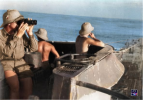
Crew of U177 with German tropical pith helmets.
U-177 was the deadliest U-Boat active off the South African coastline. Amongst other kills, she sank the RMS Nova Scotia off Richard’s Bay, which remains South Africa’s worst maritime disaster. Her hunting ground was solely off the South African eastern seaboard and Mozambique Channel. I have therefore included her entire service record below.

Type IXD2 U-177 was laid down on 25 November 1940, at the DeSchiMAG AG Weser yard in Bremen, as yard number 1017. She was launched on 1 October 1941, and commissioned on 14 March 1942, under the command of Kapitänleutnant Wilhelm Schulze. After a period of training with the 4th U-boat Flotilla at Stettin, the boat was transferred to the 10th flotilla on 1 October 1942, and based at Lorient, for front-line service, she was then reassigned to the 12th flotilla at Bordeaux on 1 December.She sank 14 ships of 87,388 gross register tons (GRT) and damaged one other of 2,588 GRT, but was herself sunk on 6 February 1944, in the Atlantic west of Ascension Island by a US Navy aircraft.
First patrol
Under the command of Kptlt. Robert Gysae, U-177 left Kiel on 17 September 1942, and sailed north around the British Isles. On 23 September, the U-boat was bombed by a twin-engine aircraft southeast of Iceland, but crash-dived and sustained no damage. She then headed south to the waters off South Africa and Mozambique. There she sank eight ships totaling 49,371 GRT and damaged another of 2,588 GRT:She had her first success on 2 November, sinking the unescorted 4,538 GRT Greek merchant steamer Aegeus off Cape Columbine. There were no survivors.On 9 November, the U-boat attacked and damaged the unescorted 2,588 GRT British oil tanker Cerion south of Port Elizabeth with her 37 mm and 20 mm AA guns, after her deck gun malfunctioned, and several attacks with torpedoes failed.The 7,006 GRT British tanker Scottish Chief was the next victim on 19 November; she was loaded with 13,000 tonnes (13,000 long tons; 14,000 short tons) of fuel oil, and was torpedoed by U-177 about 200 miles (320 km) east southeast of Durban. The ship exploded and sank in flames, with only 12 of the crew of 48 surviving. The unescorted 7,191 GRT Liberty ship Pierce Butler was hit by two torpedoes from U-177 on 20 November. The ship's armed guards opened fire with her five-inch (130 mm) and three-inch (76 mm) guns, while the engines were secured; subsequently the eight officers, 33 crewmen and 21 armed guards abandoned ship in four lifeboats. Within half an hour the ship sank. Pierce Butler's third mate was questioned by officers from U-177 who offered to send a distress signal if none had been sent. The ship had, and the crew were picked up about 20 hours later by HMS Fortune. U-177 next sank the unescorted 6,796 GRT British troop transport RMS Nova Scotia southeast of Lourenço Marques on 28 November. The ship was carrying mail, passengers and 780 Italian prisoners of war and civilian internees from Port Tewfik, Massawa and Aden to Durban. Hit by three torpedoes, she sank within ten minutes. The U-boat picked up two survivors to identify the ship, who turned out to be Italian merchant sailors. Mindful of the Laconia Order issued two months previously, Gysae radioed the BdU (U-boat headquarters) and was ordered to continue his patrol while they notified the Portuguese authorities, who sent the frigate Afonso de Albuquerque to help. The frigate rescued only 194 survivors. From the 1,052 aboard, 858 were lost, including 650 Italians.
On 30 November, she sank the unescorted 10,799 GRT British troop transport Llandaff Castle with two torpedoes southeast of Lourenço Marques. The former Union-Castle Line passenger ship had 150 passengers on board, including six Soviet diplomats with their wives and children and 70 military officers with their families. Three crew members were lost. The survivors were later rescued by HMS Catterick.U-177 torpedoed the unescorted 3,548 GRT Greek merchant ship Saronikos off Mozambique, on 7 December, which broke in half and sank within two minutes. The Germans questioned the only two survivors from the crew of 38, and provided them with bandages and provisions. The boat torpedoed the unescorted 6,408 GRT British merchant ship Empire Gull on 12 December, in the Mozambique Channel, allowing the crew to abandon ship before opening fire with her deck gun, firing 70 incendiary and 100 high-explosive rounds, and scoring about 140 hits, which finally caused the ship to sink. Two crew members were lost in the attack, the master and 43 crewmen were later rescued up by HMS Inconstant and HMS Freesia.
On 14 December, the U-boat sank the 3,085 GRT Dutch merchant ship Sawahloento with her last torpedo, her destruction took seven minutes. The crew of 72 men abandoned ship in four lifeboats, three of which capsized when the boiler exploded, drowning most of the occupants. The 19 survivors in the last lifeboat were questioned, and then set sail towards the coast of South Africa, arriving two days later. U-177 then headed for France, arriving in Bordeaux on 22 January 1943, after a voyage of 128 days.
Second patrol
U-177 left Bordeaux, 1 April 1943, for her second patrol around the Cape of Good Hope, where she sank six ships totalling 38,017 GRT. She attacked Convoy CD-20, 27 May, with a salvo of four torpedoes, hitting the 6,679 GRT United States merchant ship Agwimonte and the 7,886 GRT Norwegian tanker Storaas. Both ships were abandoned by their crews and were sunk with further torpedoes from U-177. On 6 July the unescorted 7,129 GRT Canadian merchant ship Jasper Park was hit by two torpedoes from U-177, south southwest of Cap Sainte Marie, the extreme southern point of Madagascar. The U-boat fired another torpedo which either missed or was a dud, so she surfaced to sink the vessel with gunfire, but as she did so her target sank.
On 10 July 1943, U-177 struck the unescorted 7,176 GRT American Liberty ship Alice F. Palmer, with a single torpedo in the stern, blowing off the propeller and rudder, flooding the engine room, and breaking the back of the ship. The crew of 68 abandoned their vessel in four lifeboats, and after questioning them, U-177 shelled the ship, firing 14 incendiary and 85 high-explosive rounds. The burning ship slowly sank. The four lifeboats eventually sailed to Madagascar.The 4,952 GRT British collier Cornish City was torpedoed and sunk on 29 July, southeast of Madagascar. The ship sank within a minute with the loss of 37 of her crew of 43. The survivors were questioned by the Germans and later picked up by HMAS Nizam.The U-boat successfully attacked the unescorted 4,195 GRT Greek merchant ship Efthalia Mari east of Madagascar on 5 August, after spotting her using a Fa 330 Bachstelze rotor kite. Hit by two torpedoes, the ship sank in eight minutes. U-177 was one of only a few U-boats equipped with the aerial observation platform, and the only one to have successfully used it.
The submarine returned to Bordeaux, 1 October 1943, after 184 days at sea.

Commander of U-177 Kapitänleutnant Robert Gysae in 1941 (right) and after returning from the Second Patrol, October 1943.
Gysae went on to serve in the German Navy after the war.
Third patrol and loss
Under the command of Korvettenkapitän Heinz Buchholz, U-177 sailed from La Pallice, where she had docked 26 December 1943, 2 January 1944, and once again headed south. On the 36th day of the patrol, 6 February, she was sunk in the Atlantic west of Ascension Island, in position 10°35′S 23°15′W, by depth charges dropped by a P4BY-1 Liberator bomber from VB-107. Fifty men were lost; 15 survived, they were picked up by USS Omaha.































































